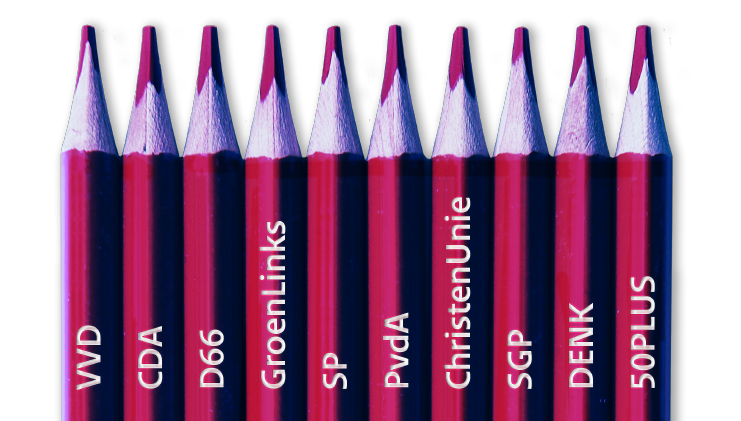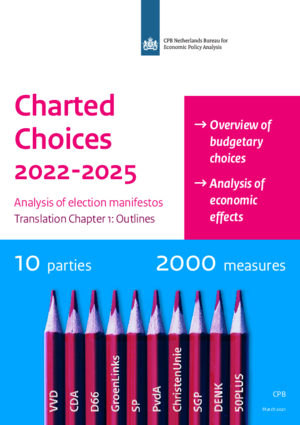Charted Choices 2022-2025
CPB presents 10th edition election manifestos analysis

Participation in the ‘Charted Choices’ analysis is voluntary. This year, the VVD, CDA, D66, GroenLinks, SP, PvdA, ChristenUnie, SGP, DENK and 50PLUS accepted CPB’s invitation to have the economic impact of their election manifestos analysed. The analysis concretises the plans of the parties and is based on a uniform methodology for all, which enables clear comparison between the budgetary and economic consequences of the various policy choices.
Choices and trade-offs
For this year’s Charted Choices — CPB’s 10th version since the start of this series in 1986 — close to 2000 measures were analysed. Often, there are trade-offs; for example, when higher expenditures may stimulate economic growth in the short term, but transfer the financial burden to future generations. These are political considerations. The analysis outlines these trade-offs, but does not provide an opinion on the choices made by the parties.
No voting advice application
CPB analyses the budgetary and economic effects of policy measures. This is, of course, only one aspect of the policy choices that parties are faced with, at election time. CPB’s analysis, therefore, cannot be compared to a voting advice tool. In addition to CPB’s analysis, a number of political parties have also had other aspects of their election manifestos analysed by PBL Netherlands Environmental Assessment Agency (for more information on that particular analysis, see PBL’s website).
Note to the editor:
For more information on particular subjects in CPB’s analysis, please contact the related CPB experts:
| Subject | Contact | Telephone number |
| General information & interview requests | Jeannette Duin | +31 (0)6 15698340 |
| Project leader Charted Choices (Keuzes in Kaart) | Diederik Dicou | +31 (0)6 22827239 |
| Budget, EMU balance and government debt | Bert Smid | +31 (0)6 11594311 |
| Health care | Jonneke Bolhaar | +31 (0)6 46941319 |
| Macroeconomic effects | Wim Suyker | +31 (0)6 52485860 |
| Purchasing power | Patrick Koot | +31 (0)6 46360575 |
| Long-term policy effects on income distribution | Patrick Koot | +31 (0)6 46360575 |
| Structural employment effects | Yvonne Adema | +31 (0)6 15011560 |
| Financial burden for future generations | Iris van Tilburg | +31 (0)6 31754461 |
| Housing market | Francis Weyzig | +31 (0)6 27511852 |
| Environment | Esther Mot | +31 (0)6 11523709 |
| Climate | Sander Hoogendoorn | +31 (0)6 29997476 |
| Mobility and Transport | Rob Euwals | +31 (0)6 55736513 |
FAQs:
How useful is this analysis, now that there is uncertainty about the economic outlook due to the COVID-19 pandemic?
Even with the uncertainty that is created by the coronavirus crisis, the analysis has added value. After all, its value is not so much in projecting the outcomes of a single party’s election manifesto, but rather relates to the comparison between those of all the participating parties. Moreover, we are looking at the full government term (in this case, 2022–2025) as well as the long term and, from that perspective, the coronavirus-related uncertainty is small, compared to the shorter term.
Are the results as certain as they are currently presented?
There is always uncertainty when it comes to these types of analyses. The results must primarily be seen as an instrument that provides insight into differences between what parties intend to do and how this would affect the economy. In this respect, the uncertainty about policy effects is smaller than the uncertainty regarding future economic development.
Why are only 10 election manifestos included in the analysis?
Participation in the analysis is voluntary; it is an intensive process, within a short timeframe, which makes great demands on CPB’s capacity. In order to guarantee high-quality results, CPB is unable to include the manifestos of all of the political parties that are participating in the general elections — this year, there are 37 of them. Therefore, only the 13 parties that had won seats in the previous general elections were invited by CPB to participate in this year’s analysis.
How many political parties participated in the previous analysis of election manifestos?
In 2017, a total of 11 parties participated. This time, the 50PLUS party is participating for the first time, while the other parties involved in the current analysis also participated in 2017. Participants in that year who are not in this year’s analysis are VNL and the Vrijzinnige Partij.
Hierboven kunt u de videoregistratie bekijken van de persconferentie in perscentrum NieuwsPoort waar CPB en PBL de doorrekeningen op 1 maart 2021 gepresenteerd hebben.
De doorrekening van de verkiezingsprogramma’s is beschikbaar in de vorm van te downloaden PDF-bestanden met uitleg en verwijzingen. Daarnaast is er een interactieve datavisualisatie, die inzicht geeft in de onderlinge verschillen tussen partijen. Bekijk ook de presentatie die gebruikt is tijdens de persconferentie. Alle relevante CPB-publicaties voor deze doorrekening zijn ook te vinden op de verkiezingen-tijdlijn.
Downloads
The PDF-download is a translation of chapter 1 of the Dutch publication.
Contacts


